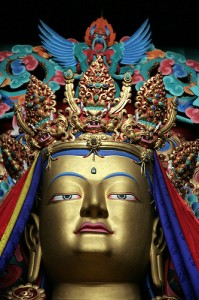This is the final installment of Willow Moon’s comparison of his dual observance of Faerie Witchcraft and Tibetan Buddhism. Here are the previous parts one and two. I am so grateful to have such a thoughtful practitioner share their observances with us!
*****
Ethics are perhaps the area where Buddhism and Faerie Witchcraft diverge the most. In Buddhism there are many rules for conduct but they all boil down to the basic ethics associated with the three levels of vows taken before initiation. In Buddhist practice one must receive these vows from someone who has received the vows and maintained them. In the Tibetan system the first level of vows is taken when one does the formal ceremony of becoming a Buddhist. The entry level vow is not to harm living beings. This includes torturing or sacrificing animals for food or divine favors. One is allowed to eat meat if it is already dead but to kill an animal is considered dangerous, as this means the killer will be killed in the future if not moderated by compassion, purification, prayer or meditation.
The second level of vows is the vow of a Bodhisattva, someone who helps others with no strings attached; without anger, deceit, fear or need. This vow is the promise to forgo the luxury of indifference and actively help others. This is the promise to go out of your way to unselfishly help others in need and to give more back to the world than you receive.
The third level of vows is the Vajrayana vow to maintain your connection to the lineage of enlightened masters. These people are not masters over someone else but those who have mastered the teachings and received the nectar of practice. Maintaining the connection is remembering the teachings and the teacher, applying the teachings appropriately and sustaining a loving and open attitude. This is considered to be critical to obtain the goal, one must do the necessary work but that isn’t enough to receive the blessings of the lineage. Through the blessings of one’s teachers your mind can flower into your full potential like a flower opened by the blessings of the sun.

Of course, this short discussion of Buddhist ethics would be incomplete without touching upon Buddhist cause-effect: karma. Many in the west seem to misunderstand this aspect of life. Sometimes I have heard westerners say something like: “it’s your karma, so you deal with it!” in order to absolve themselves of any culpability. The purpose of karma is as an incentive to better yourself and as a comfort against harm done to you by encouraging hope for change. It is not a ruler to judge, punish and abuse people with or to make you feel better about the terrible things that happen to them!
I was told by my wonderfully wise teacher Venerable Lama Sonam Tendzin that karma operated like two hooks meeting and hooking together. The inner hook is all your habits and tendencies to act, feel or think in a certain way. The outer hook is all the circumstances of life that are presented to you. When these two hooks meet and connect your personal experiences arise before you. If you want to change your personal experience then you must change your inner hook so that it doesn’t hook up with circumstances you don’t want. The inner hook is changed by ritual devotion to the Buddha-Guru-Deity, by meditating, by introspection and by acting kindly toward oneself and others. The beauty of karma is that if you are doing beneficial activities your life experience will get better, but if you are harming others, you will be harmed in turn. It is very simple: the secret to happiness is to treat everyone else the way you would want to be treated.
Faerie Witchcraft ethics on the other hand are quite different. Some Faerie Witches adopt the standard Wiccan ethics of: “Whatever you put out will return to you three-fold” and “An ye harm none, do what you will.” These concepts are not native to Faerie Witchcraft as taught by Victor and Cora Anderson but were lifted from Gardnerian Witchcraft and Thelema. That would be fine, as Pagans and Witches in general are free to adopt new ideas and practices into their personal path. However, the problem is that the common understanding of the three-fold law of return reflects a misunderstanding of Gardnerian practice. Receiving three times what you put out isn’t even an accurate depiction of karma! In addition, the Thelemic ‘an ye harm none’ rule can be confusing. If you protect yourself or a loved one from an attack, isn’t that harming the attacker? Some take this Thelemite rule to mean that one cannot cast a spell on someone without their expressed consent. If someone is sick and can’t ask for help, then one is not allowed to do a healing spell! If you wanted to bind a serial rapist but they didn’t consent to the binding then the spell is considered unethical! I understand the wish not to harm others, but does that include allowing ongoing harm to continue?
In Faerie Witchcraft we typically don’t operate in such a fashion. Instead of second-guessing and doubting our intuition and our magic we tend to cast spells in such a way that it is sent from the Witches’ God-self to the God-self of the target. Our God-self is the best part of us and thus She has only beneficial intentions toward ourselves. Since our own personal God-self has only our best interest at heart, She cannot cause harm to us. By sending a healing spell through the God-self of the recipient, they will only receive what is best for them, in an appropriate way and time.
This is based upon the understanding that when each of us is born we have an unalloyed awareness. At birth we are not mixed up with anger, hatred or fears which cause one to intend harm. These things are learned later in life. Even a future criminal has an original good heart, albeit covered completely with psychic offal. This is different from the common western belief that we are born from evil or flawed. In both Buddhism and Faerie Witchcraft each living being is understood to have been born with a pure heart!
I have found that practicing Buddhism has improved my practice of Witchcraft and practicing Witchcraft has improved my practice of Buddhism. Buddhism has increased my ability to focus, visualize, relax, and connect to inner wisdom which are all necessary skills for working magic. Practicing the Buddhist teachings has also generated greater compassion in my mind which helps me to connect more deeply with people, animals, spirits and Gods. Faerie has increased my appreciation of the beauty, magical display and mystery of myself, the world and of others.
The goals of Buddhism and Faerie are different yet similar. The goal of Buddhist practice is to obtain enlightenment and then use that power and wisdom to help others. The goal of Faerie according to Cora Anderson is to become a better person.















